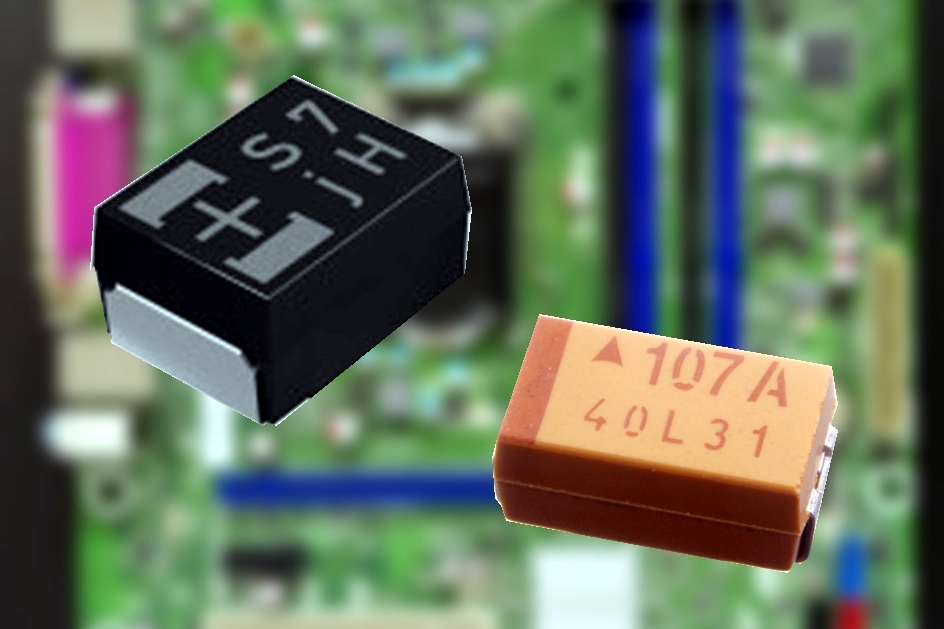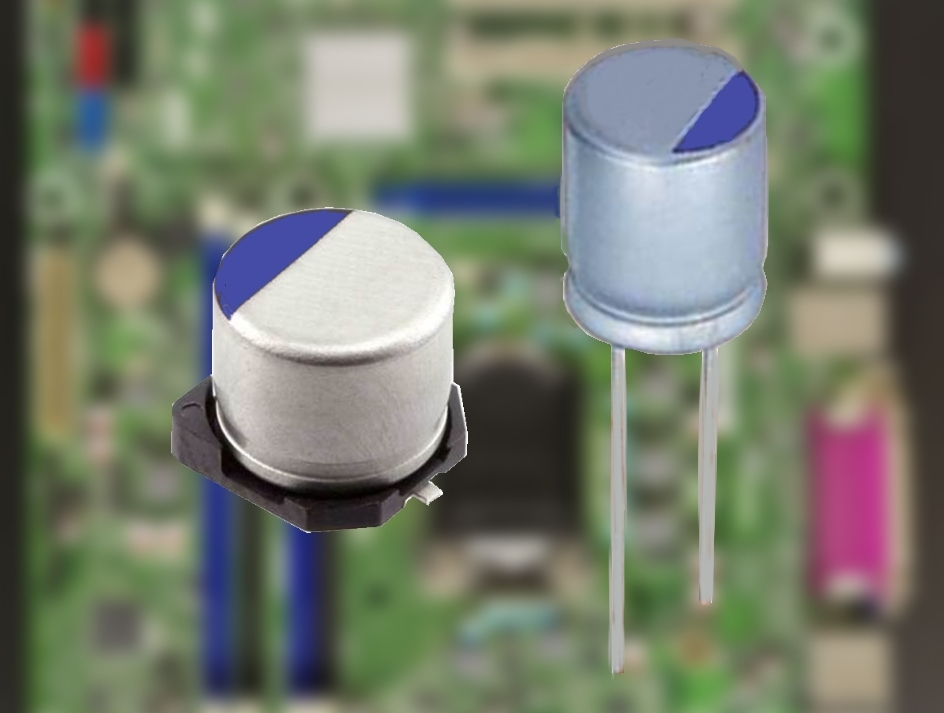|
Polymer Capacitor
A polymer capacitor, or more accurately a polymer electrolytic capacitor, is an electrolytic capacitor (e-cap) with a solid conductive polymer electrolyte. There are four different types: * Polymer tantalum capacitor, tantalum electrolytic capacitor (Polymer Ta-e-cap) * Polymer aluminum electrolytic capacitor, aluminium electrolytic capacitor (Polymer Al-e-cap) * Hybrid polymer capacitor (Hybrid polymer Al-e-cap) * Polymer Niobium capacitor, niobium electrolytic capacitors Polymer Ta-e-caps are available in rectangular surface-mounted device (Surface-mount technology, SMD) chip style. Polymer Al-e-caps and hybrid polymer Al-e-caps are available in rectangular surface-mounted device (SMD) chip style, in cylindrical SMDs (V-chips) style or as radial leaded versions (single-ended). Polymer electrolytic capacitors are characterized by particularly low internal equivalent series resistances (ESR) and high ripple current ratings. Their electrical parameters have similar temperature de ... [...More Info...] [...Related Items...] OR: [Wikipedia] [Google] [Baidu] |
Bell Laboratories
Nokia Bell Labs, originally named Bell Telephone Laboratories (1925–1984), then AT&T Bell Laboratories (1984–1996) and Bell Labs Innovations (1996–2007), is an American industrial research and scientific development company owned by multinational company Nokia. With headquarters located in Murray Hill, New Jersey, the company operates several laboratories in the United States and around the world. Researchers working at Bell Laboratories are credited with the development of radio astronomy, the transistor, the laser, the photovoltaic cell, the charge-coupled device (CCD), information theory, the Unix operating system, and the programming languages B, C, C++, S, SNOBOL, AWK, AMPL, and others. Nine Nobel Prizes have been awarded for work completed at Bell Laboratories. Bell Labs had its origin in the complex corporate organization of the Bell System telephone conglomerate. In the late 19th century, the laboratory began as the Western Electric Engineering Department, l ... [...More Info...] [...Related Items...] OR: [Wikipedia] [Google] [Baidu] |
Hideki Shirakawa
is a Japanese chemist, engineer, and Professor Emeritus at the University of Tsukuba and Zhejiang University. He is best known for his discovery of conductive polymers. He was co-recipient of the 2000 Nobel Prize in Chemistry jointly with Alan MacDiarmid and Alan Heeger. Early life and education Hideki Shirakawa was born in Tokyo, Japan, the second son of a military doctor. He had one elder and one younger brother and sister. Olympic marathoner champion Naoko Takahashi is his second cousin-niece. He lived in Manchukuo and Taiwan during childhood. Around third grade, he moved to Takayama, Gifu, which is the hometown of his mother. Shirakawa graduated from Tokyo Institute of Technology (Tokyo Tech) with a bachelor's degree in chemical engineering in 1961, and his doctorate in 1966. Afterward, he obtained the post of assistant in Chemical Resources Laboratory at Tokyo Tech. Career While employed as an assistant at Tokyo Institute of Technology (Tokyo Tech) in Japan, Shirak ... [...More Info...] [...Related Items...] OR: [Wikipedia] [Google] [Baidu] |
Alan MacDiarmid
Alan Graham MacDiarmid, ONZ FRS (14 April 1927 – 7 February 2007) was a New Zealand-born American chemist, and one of three recipients of the Nobel Prize for Chemistry in 2000. Early life and education MacDiarmid was born in Masterton, New Zealand as one of five children – three brothers and two sisters. His family was relatively poor, and the Great Depression made life difficult in Masterton, due to which his family shifted to Lower Hutt, a few miles from Wellington, New Zealand. At around age ten, he developed an interest in chemistry from one of his father's old textbooks, and he taught himself from this book and from library books. MacDiarmid was educated at Hutt Valley High School and Victoria University of Wellington. In 1943, MacDiarmid passed the University of New Zealand's University Entrance Exam and its Medical Preliminary Exam. He then took up a part-time job as a "lab boy" or janitor at Victoria University of Wellington during his studies for a BSc degree, w ... [...More Info...] [...Related Items...] OR: [Wikipedia] [Google] [Baidu] |
Alan J
Alan may refer to: People *Alan (surname), an English and Turkish surname *Alan (given name), an English given name **List of people with given name Alan ''Following are people commonly referred to solely by "Alan" or by a homonymous name.'' *Alan (Chinese singer) (born 1987), female Chinese singer of Tibetan ethnicity, active in both China and Japan *Alan (Mexican singer) (born 1973), Mexican singer and actor *Alan (wrestler) (born 1975), a.k.a. Gato Eveready, who wrestles in Asistencia Asesoría y Administración *Alan (footballer, born 1979) (Alan Osório da Costa Silva), Brazilian footballer *Alan (footballer, born 1998) (Alan Cardoso de Andrade), Brazilian footballer *Alan I, King of Brittany (died 907), "the Great" *Alan II, Duke of Brittany (c. 900–952) *Alan III, Duke of Brittany(997–1040) *Alan IV, Duke of Brittany (c. 1063–1119), a.k.a. Alan Fergant ("the Younger" in Breton language) *Alan of Tewkesbury, 12th century abbott *Alan of Lynn (c. 1348–1423), 15th cent ... [...More Info...] [...Related Items...] OR: [Wikipedia] [Google] [Baidu] |
Conducting Polymer
Conductive polymers or, more precisely, intrinsically conducting polymers (ICPs) are organic polymers that Electrical conductance, conduct electricity. Such compounds may have metallic conductivity or can be semiconductors. The biggest advantage of conductive polymers is their processability, mainly by Dispersion (chemistry), dispersion. Conductive polymers are generally not thermoplastics, ''i.e.'', they are not thermoformable. But, like insulating polymers, they are organic materials. They can offer high electrical conductivity but do not show similar mechanical properties to other commercially available polymers. The electrical properties can be fine-tuned using the methods of organic synthesis and by advanced dispersion techniques. History Polyaniline was first described in the mid-19th century by Henry Letheby, who investigated the electrochemical and chemical oxidation products of aniline in acidic media. He noted that reduced form was colourless but the oxidized forms were ... [...More Info...] [...Related Items...] OR: [Wikipedia] [Google] [Baidu] |
Sanyo
, stylized as SANYO, is a Japanese electronics company and formerly a member of the Fortune Global 500, ''Fortune'' Global 500 whose headquarters was located in Moriguchi, Osaka, Moriguchi, Osaka prefecture, Japan. Sanyo had over 230 subsidiaries and affiliates, and was founded by Toshio Iue in 1947. On December 21, 2009, Panasonic completed a 400 billion yen ($4.5 billion) acquisition of a 50.2% stake in Sanyo, making Sanyo a subsidiary of Panasonic. In April 2011, Sanyo became a wholly owned subsidiary of Panasonic, with its assets integrated into the latter's portfolio. History Beginnings Sanyo was founded when Toshio Iue the brother-in-law of Konosuke Matsushita and also a former Panasonic Corporation, Matsushita employee, was lent an unused Matsushita plant in 1947 and used it to make bicycle generator lamps. Sanyo was incorporated in 1949; in 1952 it made Japan's first plastic radio and in 1954 Japan's first pulsator-type washing machine. The company's name means ''thre ... [...More Info...] [...Related Items...] OR: [Wikipedia] [Google] [Baidu] |
Tetrathiafulvalene
Tetrathiafulvalene is an organosulfur compound with the formula (. Studies on this heterocyclic compound contributed to the development of molecular electronics. TTF is related to the hydrocarbon fulvalene, , by replacement of four CH groups with sulfur atoms. Over 10,000 scientific publications discuss TTF and its derivatives. Preparation The high level of interest in TTFs has spawned the development of many syntheses of TTF and its analogues. Most preparations entail the coupling of cyclic building blocks such as 1,3-dithiole-2-thion or the related 1,3-dithiole-2-ones. For TTF itself, the synthesis begins with the trithiocarbonate , which is S-methylated and then reduced to give , which is treated as follows: :H2C2S2CH(SCH3) + HBF4 -> 2C2S2CH+F4- + HSCH3 :2 2C2S2CH+F4- + 2 Et3N -> (H2C2S2C)2 + 2 Et3NHBF4 Redox properties Bulk TTF itself has unremarkable electrical properties. Distinctive properties are, however, associated with salts of its oxidized derivatives, suc ... [...More Info...] [...Related Items...] OR: [Wikipedia] [Google] [Baidu] |
7,7,8,8-tetracyanoquinodimethane
Tetracyanoquinodimethane (TCNQ) is the organic compound with the formula . This cyanocarbon, a relative of para-quinone, is an electron acceptor that is used to prepare charge transfer salts, which are of interest in molecular electronics. Preparation and structure TCNQ is prepared by the condensation of 1,4-cyclohexanedione with malononitrile, followed by dehydrogenation of the resulting diene with bromine: : : The molecule is planar, with D2h symmetry. Reactions Like tetracyanoethylene (TCNE), TCNQ is easily reduced to give a blue-coloured radical anion. The reduction potential is about −0.3 V relative to the ferrocene/ferrocenium couple. This property is exploited in the development of charge transfer salts. TCNQ also forms complexes with electron-rich metal complexes. Charge transfer salts TCNQ achieved great attention because it forms charge-transfer salts with high electrical conductivity. These discoveries were influential in the development of organic electron ... [...More Info...] [...Related Items...] OR: [Wikipedia] [Google] [Baidu] |
Polymer Capacitor
A polymer capacitor, or more accurately a polymer electrolytic capacitor, is an electrolytic capacitor (e-cap) with a solid conductive polymer electrolyte. There are four different types: * Polymer tantalum capacitor, tantalum electrolytic capacitor (Polymer Ta-e-cap) * Polymer aluminum electrolytic capacitor, aluminium electrolytic capacitor (Polymer Al-e-cap) * Hybrid polymer capacitor (Hybrid polymer Al-e-cap) * Polymer Niobium capacitor, niobium electrolytic capacitors Polymer Ta-e-caps are available in rectangular surface-mounted device (Surface-mount technology, SMD) chip style. Polymer Al-e-caps and hybrid polymer Al-e-caps are available in rectangular surface-mounted device (SMD) chip style, in cylindrical SMDs (V-chips) style or as radial leaded versions (single-ended). Polymer electrolytic capacitors are characterized by particularly low internal equivalent series resistances (ESR) and high ripple current ratings. Their electrical parameters have similar temperature de ... [...More Info...] [...Related Items...] OR: [Wikipedia] [Google] [Baidu] |
Equivalent Series Inductance
Equivalent series inductance (ESL) is an effective inductance that is used to describe the inductive part of the impedance of certain electrical components. Overview The theoretical treatment of devices such as capacitors and resistors tends to assume they are ''ideal'' or "perfect" devices, contributing only capacitance or resistance to the circuit. However, all physical devices are connected to a circuit through conductive leads and paths, which contain inherent, usually unwanted, inductance. This means that physical components contain some inductance in addition to their other properties.{{Cite book, last=Maniktala, first=Sanjaya, url=https://books.google.com/books?id=zMVTv6py7woC&dq=%22Equivalent+series+inductance%22&pg=PA631, title=Switching Power Supplies A - Z, date=2012-04-18, publisher=Elsevier, isbn=978-0-12-386533-5, pages=631, language=en An easy way to deal with these inherent inductances in circuit analysis is by using a lumped element model to express each physic ... [...More Info...] [...Related Items...] OR: [Wikipedia] [Google] [Baidu] |






